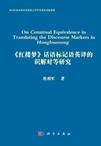《红楼梦》话语标记语英译的识解对等研究
2012-6
科学出版社
祖利军
259
《话语标记语英译的识解对等研究》首次提出“识解对等”,把翻译策略研究引向更深入的认知层面,从而为翻译研究提供了一个全新的认识途径。在翻译过程中,策略是语言表象,识解是内在动因。本书的意义和价值具体表现在翻译实践本体意义,作者首次对话语标记语的英译进行系统研究;理论建构意义,鉴于汉语中存在一些具有汉文化特色的话语标记语,作者拓展了本土话语标记语理论的研究。
AcknowledgementsChapter 1 IntroductionChapter 2 Defining and Classifying DMs2.1 DMs in English and Chinese2.2 Functional diversity of DMs2.3 Classification of DMs2.4 Instantiating the pragmatic functions of DMs in Hongloumeng2.4.1 Opinion-indicating2.4.2 Deduction-eliciting2.4.3 Evidence-quoting2.4.4 Topic-initiating2.4.5 Fact-revealing2.4.6 Cause-and-effect identifying2.5 SummaryChapter 3 Toward a Working Translation Critierion: Construal Equivalence3.1 Traditional translation criteria3.1.1 Traditional Chinese translation criteria: fidelity based on aesthetics3.1.2 Traditional western translation criteria: equivalence based on linguistics3.2 Toward a working translation criterion: construal equivalence3.2.1 Relationship between cognitive semantics and translation3.2.2 Definition of construal3.2.3 A working translation criterion: construal equivalence3.3 Factors affecting construal equivalence3.3.1 Linguistic factors3.3.2 The translator's manipulation3.4 Significance of translation equivalence3.5 SummaryChapter 4 Strategies in Relation to Perspective-based Equivalence4.1 Shifts in narrative points of view4.2 Synesthetic shifts4.3 Shifts between human senses and mental processes4.4 Shifts between human senses and other processes4.5 Shifts between mental processes4.6 Shifts from generality to concreteness4.7 Syntactic shifts4.8 SummaryChapter 5 Strategies in Relation to Prominence-based Equivalence5.1 Transposition5.2 Literal translation5.3 Transmigration5.4 Structural parallelism5.5 SummaryChapter 6 Strategies in Relation to Background-based and Specificity-based Equivalence6.1 Domestication6.2 Foreignization6.3 Holism6.4 SummaryChapter 7 Implications and Future PerspectivesReferencesAppendixesAppendix A Translation of Opinion-indicatorsAppendix B Translation of Deduction-elicitorsAppendix C Translation of Evidence QuotersAppendix D Translation of TopicalizersAppendix E Translation of Fact-revealersAppendix F Translation of Cause-and-effect Identifiers
We must admit that both in China and abroad, there are re-searchers (Snell-Hornby 1988/2001:22; Hermans 1999/2004: 96-98; Lu1998; Han 1999; Liu 2000) who tend to disagree with or even reject orignore the term "equivalence". But if they make a careful exanunationof the first and second senses of the word, they will agree that theyhave made some useless efforts when critiazing. That is, in translationstudies, "equivalence" is not used in its mathematical sense as in"equivalent equation", in which the terms on the left of the equal signcan be exchanged with those on the right, for example, the equation 1+1=2 is the same as the equation 2=1+1. In still other words, backtranslation36 in most cases will end in failure, espeaally in translationbetween two languages from two separate language families, for ex-ample, between Chinese and English. In translation studies, weshould regard equivalence not as a mathematical equation but as anequivalent effect. As discussed above, equivalent effect should beachieved under the four parameters of construal equivalence.Looking back on the historical development of translation theo-ries, we can see that equivalence, which is also termed loyalty or fidel~ity or faithfulness, has never faded out of the sight of translation theo-rists. Nord has made some remarks on loyalty as follows: The translator is committed bilaterally to the source and thetarget situations and is responsible to both the ST reader (or the ini-tiator, if he is the one who takes the sender's part) and the TT recip-ient. This responsibility is what I call loyalty. ……
